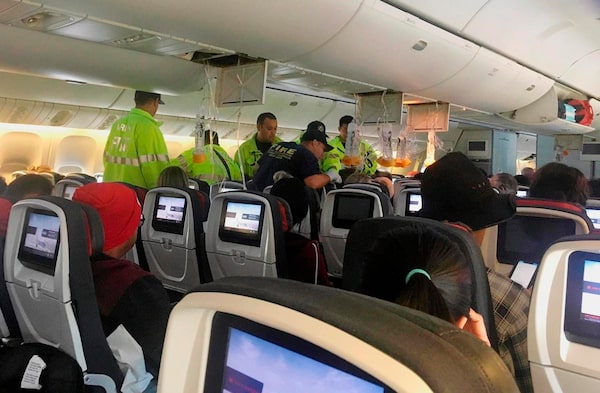
In this July 11, 2019 photo, emergency workers treat a passenger on an Air Canada flight to Australia that was diverted and landed at Daniel K. Inouye International Airport in Honolulu, Hawaii.The Canadian Press
Passengers on a flight from Canada to Australia said they had no warning about turbulence that suddenly slammed people into the ceiling of the plane and injured more than three dozen – a phenomenon that experts say can be nearly impossible for pilots to see coming.
The Air Canada flight from Vancouver to Sydney faced “unforecasted and sudden turbulence” about two hours past Hawaii on Thursday, and the plane diverted to Honolulu, airline spokeswoman Angela Mah said.
The flight made an emergency landing after 37 people were injured, nine seriously, during the sudden loss of altitude that sent people flying into the luggage compartments and aisles of the airplane.
The plane may have run into clear air turbulence , which is caused by wind patterns with no visible warning in the sky or ability for aircraft radar to pick it up. Weather forecasters also can’t help warn pilots, said Thomas Guinn of Embry-Riddle Aeronautical University in Daytona Beach, Fla.
“It’s probably one of the most challenging forecast problems we have right now for aviation meteorology,” he said.
Pilots rely on data from weather balloons and other pilots to predict turbulence but there is less information on conditions over the ocean than for over places like the continental United States., commercial airline pilot Erik Eliel said.
“It becomes less predictable when you get to areas of the world when you have less data gathering capabilities,” said Mr. Eliel, who is also president of Radar Training International Inc., a company that instructs pilots in the use of on-board weather radar systems.
Forecasters are generally able to do a good job, but it’s not a perfect science, he said.
“Until it becomes a perfect science, then you’ll always have these types of situations,” he said.
Passenger Andrew Szucs told the Associated Press that the pilot came on the radio and said they didn’t see the turbulence on radar and had “no warning this kind of air drop was going to happen.”
Mr. Szucs, originally from Ontario but now living in Sydney, said there had been turbulence before the abrupt drop and he was awake, bracing himself.
“Then all of a sudden the plane dropped and went sideways,” Mr. Szucs said, and people who weren’t strapped in “flew, hit the ceiling.”
He was not injured, but 30 people were taken to hospitals, emergency responders said.
“The plane just dropped,” passenger Stephanie Beam said. “When we hit turbulence, I woke up and looked over to make sure my kids were buckled. The next thing I knew there’s just literally bodies on the ceiling of the plane.”
A woman behind her hit the ceiling so hard she broke the casing of an oxygen mask, said Ms. Beam, of Colorado Springs, Colo.
The injured ranged in age from children to the elderly, Honolulu Emergency Medical Services Chief Dean Nakano said. People had cuts, bumps, bruises, neck pain and back pain, officials said.
Llyn Williams said when they hit the violent turbulence, “everybody who was not seated and belted in hit the roof, almost everybody in our cabin.”
Mr. Williams, whose wife was injured as they flew home to Sydney, described the cabin afterward as frightening, with plastic lying around and oxygen masks dangling.
“A lot of blood everywhere,” he said. “It was really quite scary.”
The turbulence happened at 36,000 feet about 1,000 kilometres southwest of Honolulu, U.S. Federal Aviation Administration spokesman Ian Gregor said. The Boeing 777-200 was carrying 269 passengers and 15 crew members, Air Canada said.
In other recent cases, a 2017 American Airlines flight from Athens hit severe turbulence over the New York coastline. Seven crew members and three passengers were injured.
More than 20 people were hurt in 2016 when a JetBlue plane ran into turbulence in a line of thunderstorms over South Dakota and had to make an emergency landing.
Climate change is affecting high-altitude conditions in addition to conditions on the ground, said Paul Williams, a professor of atmospheric science at the University of Reading in England who studies clear air turbulence.
“We expect more clear-air turbulence in the future,” he said.
Our Morning Update and Evening Update newsletters are written by Globe editors, giving you a concise summary of the day’s most important headlines. Sign up today.